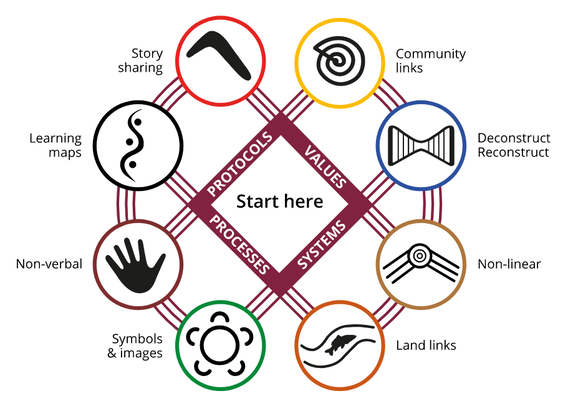Teaching on Country
IEU member Cameron Madden is a proud Yorta Yorta, Wemba Wemba man who grew up in Waddawurung Country, which is also where he works as the Koori Educator at St. Joseph’s Flexible Learning Centre.
Image via Deadly Story
This land is significant for Indigenous people because of the surrounding coastal areas, exposed middens, grey/blue ochre, scar trees and Wurdi Youang stone arrangement. In 2018 his school was approached by the Departments of Justice and Education to find ways to culturally engage Indigenous students who were disengaged from schooling. As Cameron says, ‘I jumped at the chance and haven’t looked back.’
Conversations about the systematic failures of the western education model to recognise and support Aboriginal children have been reignited by the poignant documentary In My Blood It Runs. The film follows the charismatic 12-year-old Arrernte and Garrwa boy, Dujuan, who struggles with the prescriptive model of learning taught at his western school. Yet outside the classroom Dujuan’s intelligence is evident – he speaks three traditional languages, is a hunter and takes great pride in the healing spirit passed on to him by his Elders. The film explores the inherent friction between an imposed colonial education model versus ancient systems of knowledge that have existed on this land for thousands of years.
This friction is particularly harrowing given the ongoing violence and trauma that Aboriginal people experience as a result of colonialism - incarceration rates of Indigenous youth remain staggeringly high whilst the shocking images of the Don Dale case remain etched into our collective memories. Dujuan, who is smart, loving and fearless, is at risk of becoming yet another statistic.
Still from In My Blood It Runs
This brings us back to Cameron and the significance of what he has achieved at his school through a pedagogical approach that incorporates the ‘Eight Aboriginal ways of learning’ with the Victorian curriculum. Developed by Dr. Tyson Yunkaporta, the framework involves eight interconnected pedagogies which use Aboriginal knowledge systems to find common ground with mainstream modes of teaching. These include story sharing, learning maps, nonverbal techniques, the use of symbols and images, land links or land-based learning, non-linear and interdisciplinary approaches, community links and deconstruct reconstruct (for example, scaffolded genre mastery).
8 Aboriginal ways of learning model
‘We start and end each day with a Yarning circle. In the mornings our Yarning circle has a three-point purpose. Social – Cultural – Healing. All points in the Yarning circles can flow from one to another but require the social aspect of the Yarn to be accessed first, otherwise Cultural and Healing would be too difficult to access. The end of the day Yarning Circle is social and requires recall of the day or week.’ His classes also involve excursions out on country, where non-Indigenous students are also invited to attend.
The success of Cameron’s teaching methods is shown in the results – there has been a reduction in re-offending by the young people he teaches and an increase in attendance and engagement. ‘The young people enjoy the class because they are learning in environments where they feel culturally safe and supported’.
This article first appeared in The Point Vol 10 No 2 2020



